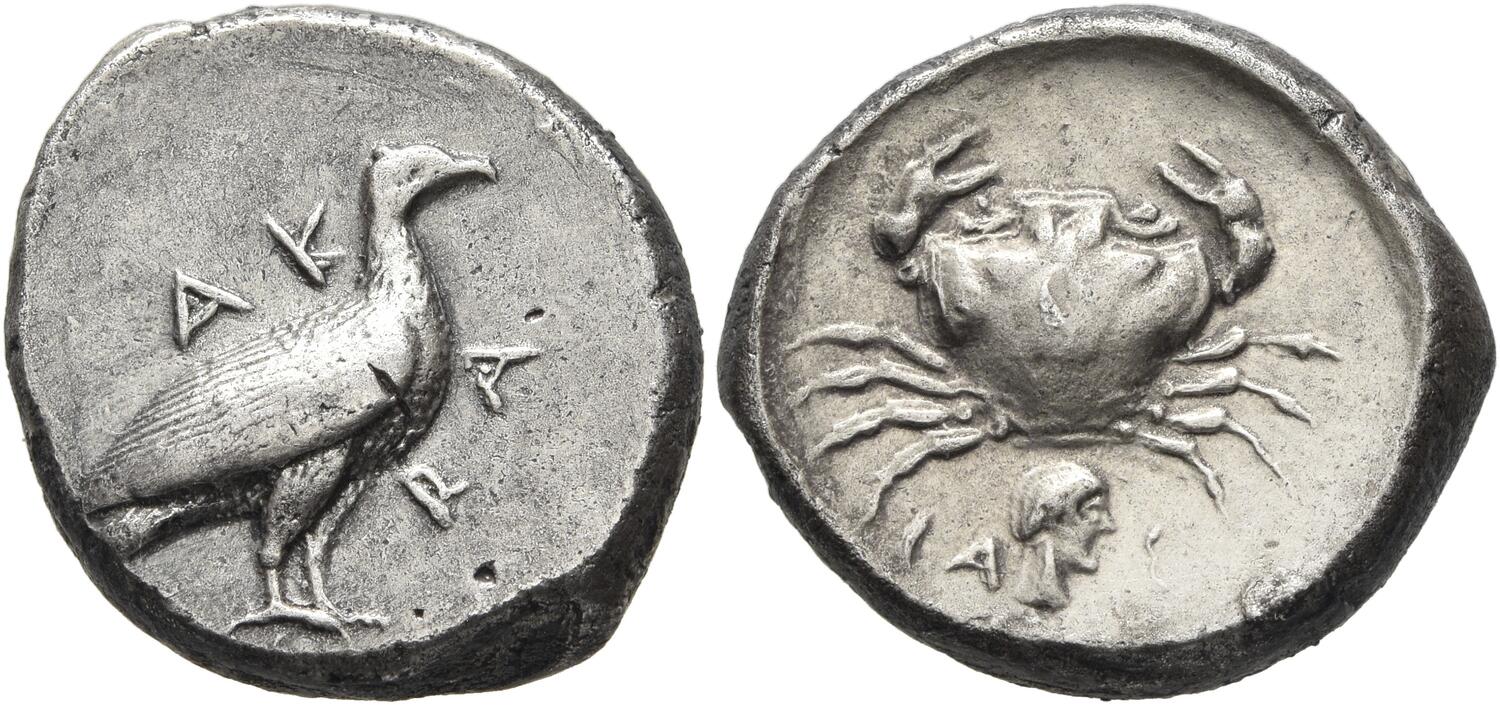922 - Caulonia (nomos Apollo/stag) over Agrigentum (eagle/crab) (Triton, XXV, Jan. 2022, 39)
From SILVER
475 BCE - 425 BCEKAVL
Location/history
| Sale(s)Sale(s) ᵖ: | Triton, XXV, 11 Jan. 2022, lot 39. From the Pythagoras Collection. Ex Classical Numismatic Group, 41, 19 March 1997, lot 137 | |
Overstriking coin
Description
| ObverseInscription or printing placed on the obverse.: | KAVL (Greek) Apollo advancing right, holding branch aloft in right hand, small daimon running right on extended left arm, retrograde KAVΛ to left, to right, stag standing right, head reverted | ReverseInscription or printing placed on the reverse.: | (Greek) Stag standing right, retrograde KAV above, laurel branch to right |
Mint and issuing power
| MintIdentifies the place of manufacture or issue of a numismatic object.: | Caulonia | Ancient regionAncient region. | Bruttium | Modern countryModern country: Italy | AuthorityIdentifies the issuing power. The authority can be "pretended" when the name or the portrait of X is on the coin but he/she was not the issuing power. It can also be "uncertain" when there is no mention of X on the coin but he/she was the issuing power according to the historical sources: |
Chronology
| FromIdentifies the initial date in a range assigned in a numismatic context. 475 BCE toIdentifies the final date in a range assigned in a numismatic context.. 425 BCE | Classical 480-323 BC |
Physical description
| MetalThe physical material (usually metal) from which an object is made.: Silver |
WeightWeight of the numismatic object (in grams). in grams: 7.917.91 g <br />7,910 mg <br /> | DenominationTerm indicating the value of a numismatic object. Examples: tetradrachm, chalkous, denarius.: nomos | AxisDescribes the directional relationship between the obverse and reverse of a numismatic object.: 88 mm <br />0.8 cm <br /> |
| DiameterDescribes diameter of an object (in mm).: 2222 mm <br />2.2 cm <br /> | |||
References
| Coin referenceReference of the Coin: | Coin series referenceReference to coin series study: | SNG ANS 3 Bruttium-Sicily1SNG ANS 3 Bruttium-Sicily, n° 175-180., HN Italy2HN Italy, n° 2044, HGC 13HGC 1, n° 1419 | |
| Coin series web referenceCoin series web references: | |||
Overstruck type
Description
| ObverseInscription or printing placed on the obverse.: | AK-PA (Greek) Eagle standing right with closed wings | ReverseInscription or printing placed on the reverse.: | CA-Σ (Greek) Crab, below, male head to right, all within shallow circular incuse. |
Mint and issuing power
| MintIdentifies the place of manufacture or issue of a numismatic object. ᵖ: | Agrigentum | Ancient regionAncient region. ᵖ | Sicily | Modern countryModern country: Italy | AuthorityIdentifies the authority in whose name (explicitly or implicitly) a numismatic object was issued. ᵖ: |
Chronology
| FromIdentifies the initial date in a range assigned in a numismatic context. 480 BCE toIdentifies the final date in a range assigned in a numismatic context.. 470 BCE | Classical 480-323 BC |
Physical description
| DenominationTerm indicating the value of a numismatic object. Examples: tetradrachm, chalkous, denarius. ᵖ: | didrachm |
References
| Coin type referenceReference to coin series study ᵖ: | Westermark 20184Westermark 2018 | ||
| Coin series web reference overstruckCoin series web references overstruck: | |||
Additional data
| Frequency of overstrikesFrequency of overstrikes: | frequent | Level of confidenceLevel of confidence of the identification: | sure |
| RemarksRemarks: | "overstruck on a didrachm of Akragas (outline of crab visible on the obverse)" | ||
References
- ^ Troxell, Hyla A. (1975), Sylloge Nummorum Graecorum ANS 3. The Collection of the American Numismatic Society. Sicily 3 (Bruttium-Sicily I: Abacaenum-Eryx), New-York, pl. 38.
- ^ Rutter N. Keith et alii (eds.) (2001), Historia Numorum Italy, London, xvi, 223 p., 43 pl.
- ^ Hoover, Oliver D. (2018), The Handbook of Greek Coinage Series, Volume 1. Handbook of Coins of Italy and Magna Graecia, Sixth to First Centuries BC., Lancaster-London, 2018, lxi, 527 pages, 23 cm
- ^ Westermark, Ulla (2018), The coinage of Akragas c. 510-406 BC, 2 vol., Uppsala.

